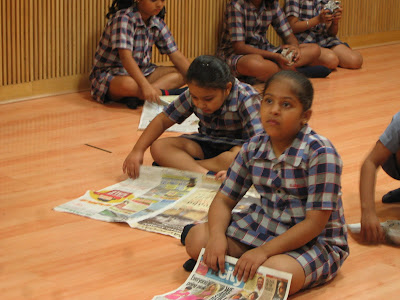Let’s do it the fun way When Joga Ram, a Class VII student of a government school in Barmer, Rajasthan, wanted to participate in a four day theatre-cum-education workshop, he was discouraged by the people in his village because he was someone who had problems concentrating on studies and they thought it would prove to be too distracting for him.
His performance in the play was so commendable, however, that he became a regular at all of his school’s stage productions. Gradually, his interest in studies also grew.
Thanks to the ‘fun’ element in such theatre workshops, most students find these help improve their academic performance as well.
“I was a maths teacher and was keen about theatre. A few years ago, I combined both to make mathematics interesting. It gets all children involved in the class activity,” says Kamlesh Tiwari, who co-founded the BNKVS Group of Theatre Society, which propagates theatre-in-education.
Play time Theatre in education has simplified the lives of students and teachers alike. With advent of theatre-oriented education, Shyam Sunder Gehlot, an elementary teacher of mathematics in a government school in Jodhpur, doesn’t struggle any more to explain the concepts of geometry.
“To teach children about different geometric shapes such as a circle, triangle and hexagon, we make them enact a play,” says Gehlot. These theatre workshops get a ‘thumbs up’ from child counsellors, who find theatre an enriching exercise.
“It improves communication skills, helps children overcome hesitation, and makes them confident. Children also make new friends (while enacting plays). It brings out different aspects of their personality,” says Pervin Malhotra, a child counsellor. Psychologist Dr Anindita S Roy has a similar opinion.
“Continuous study engenders boredom. It is important to seek the help of music, sports and sometimes yoga to help children unwind. With these methods, students can keep learning without getting bogged down. Using such teaching methodologies not only help students shape their personalities, but also better their academic performance.”
“I have seen the results of around 20 per cent students improving after we took up theatre,” adds Gehlot.
After witnessing an overwhelming response from more than two dozen schools in the oil fields in Barmer, Tiwari plans to replicate theatre-in-education in parts of Gujarat, too.
The entire exercise is spearheaded by Cairn India, an oil and gas major. Unwind to rejuvenate In elementary classes, theatre is used as a vehicle to teach mathematics, English and Hindi.
However, senior classes still have to use conventional teaching techniques, which can become monotonous. To avoid such monotony, Zion Tutorials, an IIT-JEE coaching academy in Rohini, screens interesting and motivational videos for its students. Anup Gupta, co-founder of the academy, believes in the need to unwind after classes.
“Students watch interesting videos on YouTube. The videos could relate to a dance performance or magic tricks. Though it doesn’t help them in the entrance preparation directly, it does help rejuvenate them,” he says.
Raising the bar Recreational breaks can be used to motivate, too. Divya Dawra, a student of Little Flowers Public School, Shahdara, says, “Attending classes continuously for four hours is quite difficult.
Watching inspirational videos for 15 minutes is quite a healthy break.” Recalling one such video, she says, “We were shown the story of Pranav Mistry (the inventor of Sixth Sense, a wearable interface technology) who studied at an obscure engineering college in Gujarat but went on to become a research scholar in a US university. The message we got was that you can achieve anything you want if you are focussed and hard-working.”
Experts say that if students are immersed in sports right from school, it transforms their attitude for good. “Students then learn to be competitive, develop team spirit and follow a disciplined approach in everything they do,” says Saumil Majumdar, managing director, EduSports, a company that provides sports solutions toschools across India.

































